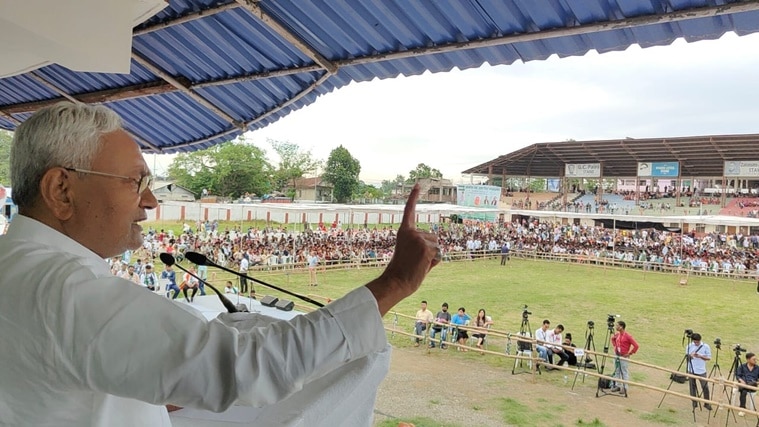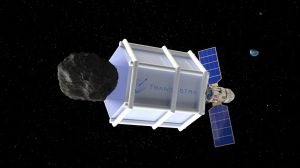Rewind & Replay | JP’s way: Hill to hill, village to village, seeking Naga peace, via ‘civilisational unity’
Nitish's Nagaland visit to mark Jayaprakash Narayan's birth anniversary shines light on forgotten bit of history; JD(U) MP says could be a pointer amid fresh push for Naga talks
 Bihar Chief Minister Nitish Kumar (right) was in Dimapur on the occasion of Jayaprakash Narayan's 120th birth anniversary. (Photos: Express Archives and Twitter/@NitishKumar)
Bihar Chief Minister Nitish Kumar (right) was in Dimapur on the occasion of Jayaprakash Narayan's 120th birth anniversary. (Photos: Express Archives and Twitter/@NitishKumar)Earlier this week, Jayaprakash Narayan’s 120th birth anniversary witnessed a tug-of-war between leaders of the erstwhile Janata Parivar and the BJP on laying claim to the legacy of the towering socialist leader.
In the competing claims of being the true inheritors of Narayan, popularly known as JP, the major thrust has invariably been on his fierce resistance against the Emergency imposed by Indira Gandhi, and ending the Congress’s dominance.
Bihar Chief Minister Nitish Kumar’s visit to Nagaland on JP’s birth anniversary, however, spotlighted an aspect of the late leader’s life that has remained largely unexplored over the years, resulting in its near erasure from the public imagination.
As JD(U) Rajya Sabha MP Anil Hegde points out, JP extensively travelled across Nagaland right through the 1950s when the Naga National Council (NNC) led by Angami Zapu Phizo had declared independence from India, inviting Indian military action.
“Many socialist leaders of that era engaged with the Northeast. And JP was no exception. But the level of interest that he displayed was remarkable. He went from hill to hill, village to village, mingled with the local people in an attempt to capture their anxieties and aspirations,” Hegde said.
Eventually, the Naga civil society took note of JP’s efforts. In 1964, the Nagaland Baptist Church Council (NBCC) set up a three-member peace mission — with the support of the Union government — including JP, then Assam Chief Minister B P Chaliha, and Anglican priest Michael Scott.
 Bihar Chief Minister Nitish Kumar addresses a rally on the occasion of the 120th birth anniversary of Jayaprakash Narayan, in Dimapur. (Photo: Twitter/@NitishKumar)
Bihar Chief Minister Nitish Kumar addresses a rally on the occasion of the 120th birth anniversary of Jayaprakash Narayan, in Dimapur. (Photo: Twitter/@NitishKumar)
The mission managed to bring the rebels to the talks table following a ceasefire agreement, which came into effect on September 6, 1964.
In his book ‘India after Gandhi’, historian Ramachandra Guha recounts how JP and Chaliha “tried valiantly to locate a common ground” between the Naga nationalists and the Indian government.
“Narayan argued that ‘compromise is possible because we think that both sides have part of the truth. If one were 100 per cent right, or 100 per cent wrong, there could be no question of compromise’,” according to the book.
Hegde said the initial success of the mission was not surprising considering JP always believed civilisational unity predates political unity.
“JP essentially emphasised on the United Kingdom model, which is made up of England, Scotland, Wales and Northern Ireland. He tried to find a middle ground by getting people to shed rigidity,” he said.
By 1966, however, the peace mission had collapsed. Guha writes that JP resigned from the mission in January 1966, saying the Nagas no longer had confidence in him.
“JP had told the underground that in the aftermath of the Indo-Pakistan war, they should drop their demand for independence, and settle for autonomy within the Indian union instead. In the federal system, foreign affairs and defence were in the hands of the Centre, but the things that most mattered — education, health, economic development, culture — were in the control of the states. So JP advised Phizo’s men to shed their arms and contest elections, thus to take over the administration by peaceful means,” according to ‘India after Gandhi’.
JP and other members of the peace mission also faced harsh criticism over their role. Scott was accused of indulging in “anti-India activities” and attempting to “internationalise” the Naga issue by approaching the United Nations.
An editorial of Indian newspaper ‘Patriot’, dated December 27, 1964, captures the brewing resentment against JP in some quarters of the Indian government too around that time. “Mr Jayaprakash Narayan owes the people an explanation for the deception that seems to have been employed. The members of the “peace mission” may find nothing improper in using pressure on the government on behalf of the hostiles but that is no reason for the Government to suffer their antics. There need be no regret if the talks break down since there is a great deal of evidence to show that the hostiles have been making use of the suspension of operations to collect arms and find recruits,” said the editorial.
Hegde said there were several reasons behind JP’s resignation from the peace mission. “There were differences of opinion with some leaders, but the sheer amount of hard work to bring peace in the state that JP put in, endeared him to the Naga people who continue to revere him,” Hegde said.
During his stay in the state, JP set up the Nagaland Peace Centre, which remains functional. As talks between the New Delhi and the NSCN(I-M) resume, the large heartedness and flexible approach adopted by JP could offer a possible roadmap towards establishing lasting peace in the region, said Hegde.


- 01
- 02
- 03
- 04
- 05




























